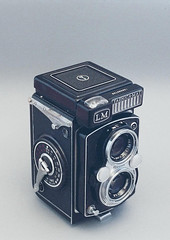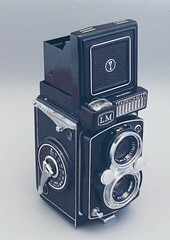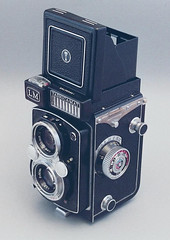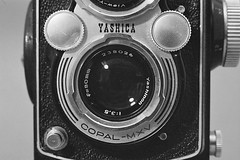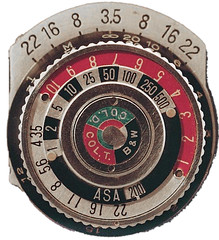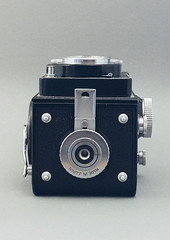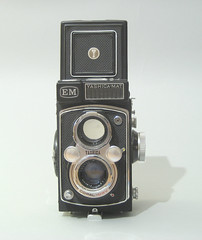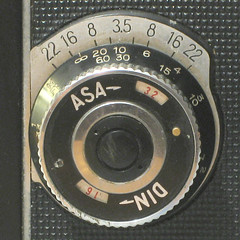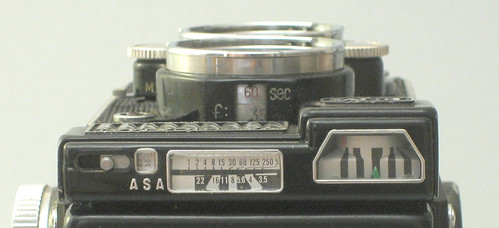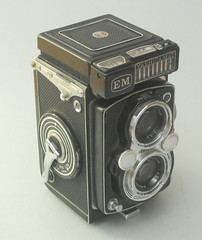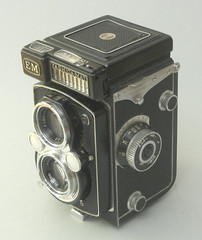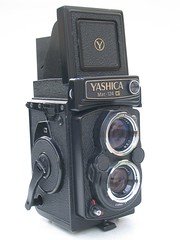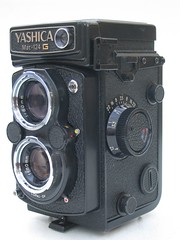Yashica 6×6 TLR (crank advance)
The Yashica company made a long line of 6×6 TLR cameras, comprising many models which were the result of a gradual evolution rather than radical change; they are conveniently divided into knob advance models and crank advance models.
Contents
The Yashica-Mat
The first Yashica TLR with crank advance was the Yashica-Mat, released in 1957.
The Yashica-Mat LM
The Yashica-Mat LM was introduced in 1958. "LM" stands for Light Meter, referring to the uncoupled selenium cell exposure meter in front of the viewfinder. It's an all-mechanical camera; even the light meter doesn't need a battery. The Yashica-Mat LM is a solidly made, easy-to-use camera.
features
It has a Copal central shutter with speeds from 1s to 1/500 and B. It offers flash sync at all speeds. The taking lens is a 3,5 Yashinon, an 80 mm four-element lens said to be of the Tessar design. It can be stopped down to F/22. The viewing lens is a 3,2 Yashinon. It accepts bay I filters. Shutter speeds and diaphragm are set by two wheels on the front plate, the values set are shown in a window above the viewing lens. Looking onto the ground glass in the waist-level finder, both values and light meter indications are visible.
Focusing is done by a focusing wheel on the left of the camera. It has a distance scale surrounded by a depth of field scale engraved in the body.
There is a small window in which you can set the ISO value of the film you use and scales for LV, shutter speeds and diaphragms.
The body is all-metal, covered by black leather. It is quite a heavy camera, about 1.2 Kg. Film transport and cocking the shutter is done by a crank. Winding makes a rattling noise.
Its viewing hood contains a fresnel screen with red grid lines (5×5) to help composition. For exact focusing, it has a magnifying loupe.
The camera is loaded by opening the bottom: turn towards the "O" to open. It uses 120-rollfilm only, on which it takes 6×6 pictures (or more accurately: 55mm × 55mm)
The Yashica-Mat EM
Released in 1964, the Yashica-Mat EM features an uncoupled light meter and an 80mm F3.5 Yashinon shooting lens. The "EM" stands for Exposure Meter, referring to the uncoupled selenium cell exposure meter in front of the viewfinder. It's an all-mechanical camera; even the light meter doesn't need a battery. The Yashica-Mat EM is a solidly made, easy-to-use camera. It can be found for a reasonable price on eBay, and is an excellent introduction to medium-format photography. It's clearly an evolution in the line of Yashica's 1957 Yashica-Mat and the 1958 Yashica-Mat LM. It differs from the latter camera only in its easier-to-use exposure meter.
Features
It has a Copal MXV leaf shutter, capable of speeds ranging from B and 1 second to 1/500s. It offers flash sync at all speeds. The taking lens is a 3.5 Yashinon, an 80 mm four-element lens said to be of the Tessar design. It can be stopped down to F/22. The viewing lens is a 3.2 Yashinon. It accepts bay I filters. Shutter speeds and diaphragm are set by two wheels on the front plate, the values set are shown in a window above the viewing lens.
Focusing is done by a focusing wheel on the left of the camera. It has a distance scale surrounded by a depth of field scale engraved in the body.
There is a small window in which you can set the ISO and DIN value of the film you use. ISO 400 is the hishest value. The exposure meter is not coupled, so setting this speed is more a riminder than of any practical use.
The body is all-metal, covered by black leather. It is quite a heavy camera, about 1.2 Kg. Film transport and cocking the shutter is done by a crank. Winding makes a rattling noise. Looking onto the ground glass in the waist-level finder, the selected shutter speed, aperture and light meter indications are visible. Its viewing hood contains a fresnel screen with red grid lines (5×5) to help composition. For exact focusing, it has a magnifying loupe.
The camera is loaded by opening the bottom: turn towards the "O" to open. It uses 120-rollfilm only, on which it takes 6×6 pictures (or more accurately: 55mm × 55mm)
Images
The Yashica Mat-124 and Mat-124G
The Yashica Mat-124G is a 6x6 TLR made by Yashica from 1971 to the mid-1980s.
The 124G has a four-element, 80mm F3.5 taking lens, of the better "Yashinon" variety. Focusing is via a ground glass screen, with a 3x diopter for critical focusing, as well as a sports finder. The Copal shutter features speeds 1 to 1/500 sec., plus B.
The 124 and 124G are largely identical, save for trim and electrical differences. The 124G pressure plate slides between 12-exposure and 24-exposure settings, while on the original 124 it pulls out and rotates. Before the 124 there were two separate models, the YashicaMat 12 (for 120 film) and the YashicaMat 24 (for 220 film). Both shared the characteristics of the later 124 and 124G.
The 124G also features a coupled match-needle exposure meter, although it uses now-discontinued 1.3v mercury cells. Suitable air-zinc replacements and adapters for modern alkaline or silver oxide batteries may be obtained at camera stores and on the internet.
The 124G can handle both 120 and 220 film, and is an excellent introduction to medium format photography. An artificially inflated demand for the 124G has raised the price somewhat in the used market.
All of these cameras accept Bay 1 accessories, such as those made for the Rolleiflex.
Links
General links
In English:
- Yashica TLR FAQ in Peter Williams' site
- Yashica-Mat EM at medfmt
- Yashica Mat-124G tribute page, by Berry de Bruijn (web archive version of a page that is now offline)
- Yashica Mat-124G picture and sample photos at Tanya Clark's website
- Yashica Mat-124G at antjam65's Photo Page
- Yashica Mat-124G featured in the TLR on a budget guide at TheBokeh.com
- Yashica Mat-124G at Lights in the Box (Lumières en Boîte), with downloadable user manual
In French:
- Yashica TLR overview and Yashica Mat-124G at Lionel's 35mm-compact.com
Manuals and documentation
- Manual of the Yashica-Mat EM and LM available on the Favorite Classics section of .kyphoto.com
- Yashica leaflet (#72E1) dated 1972, featuring the Yashica-Mat and Yashica Mat-124G along with the Yashica-635 and Yashica-D knob advance models, at Goodharbor's flickr space
- Yashica Mat-124G assembling charts at Alan Corey's Yashica Old SLR page
Photobloggers using the 124G
- PhotoRant (profile)
- Photographs taken with a 124G at groundglass.ca
- Blog by Pablo64
- seriouslyexcited.net
- Photos shot w/built in meter of Mat-124G and also sharp as a tack!
 (from the_fstop's Flickr space)
(from the_fstop's Flickr space)

